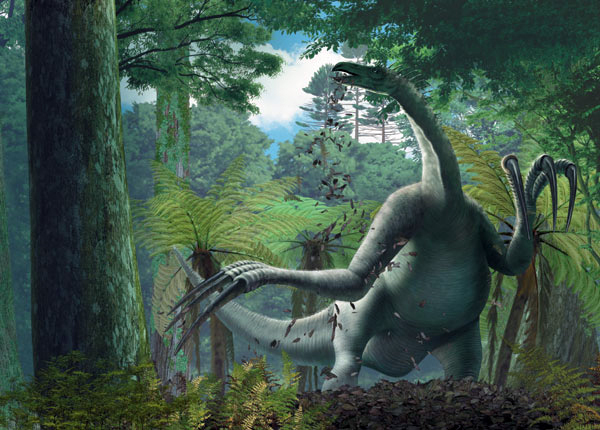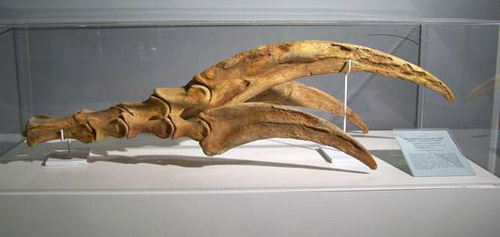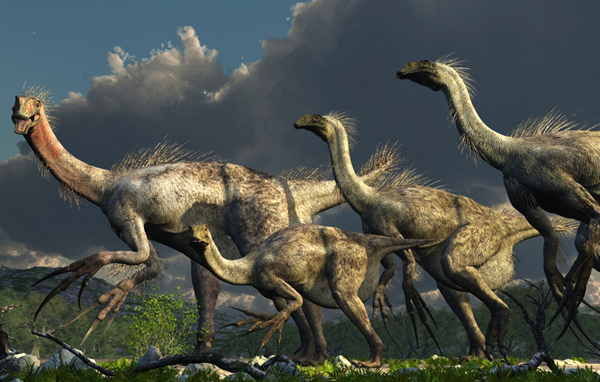The Therizinosaur
 Therizinosaurus cheloniformis, whose name means "reptile sickle", was a large bipedal dinosaur of the Late Cretaceous (74 million years ago), characterized by three claws (the largest of all dinosaurs known) on each limb.
Therizinosaurus cheloniformis, whose name means "reptile sickle", was a large bipedal dinosaur of the Late Cretaceous (74 million years ago), characterized by three claws (the largest of all dinosaurs known) on each limb.
In 1948, during an expedition to the Gobi Desert in Mongolia, scientists discovered some great bone claws. Later it was also found a fragment of another claw, an "arm", paws and teeth. However, when they were discovered fossils of this dinosaur were found to be the ribs of a giant turtle. Later, when I found his long arms to which they were attached, the Therizinosaur has been labeled as a predator. Only when other skeletal remains were finally discovered, including small head full of leaf-shaped teeth (which are ideal for cutting vegetation) scientists realized that they were dealing with a strange herbivorous dinosaur.
The long Therizinosaur was 10-12 m (33-40 ft) tall 5-6 m 15-20 ft) , weighing 2-5 tons and moved on two strong legs, keeping its long stiff tail outward. The "arms" were long as a small car. But the most striking feature of this dinosaur were the curved claws of his forearms that could reach one meter in length, about how much distance there is between the neck and wrist, if it extends an arm. After much speculation, it has come to the conclusion that it would serve its huge claws to bring the trees of which he ate and where appropriate were also used for defense. Related species such as Nothronychus were actually theropods, and most are carnivorous theropods, but among the members of the family of Therizinosaur, unusually, are only known theropod vegetarians.
the most striking feature of this dinosaur were the curved claws of his forearms that could reach one meter in length, about how much distance there is between the neck and wrist, if it extends an arm. After much speculation, it has come to the conclusion that it would serve its huge claws to bring the trees of which he ate and where appropriate were also used for defense. Related species such as Nothronychus were actually theropods, and most are carnivorous theropods, but among the members of the family of Therizinosaur, unusually, are only known theropod vegetarians.
Therizinosaurus then most probably fed on plants, but some paleontologists believe that it would be able to use its large claws to tear apart termite mounds and eat the insects that were contained within, like the current anteaters. It ' has also been suggested that it could feed on fish, so using long claws to harpooning them in the water, as now does the grizzly bear.
The Therizinosaur may have been preyed upon by carnivorous dinosaurs like Tarbosaurus, but it would be very difficult to kill prey. This means that only a desperate hunter would try to deal with this dinosaur. After all, if a prey causes of serious injury to the predator, though this can eventually kill it, you may run the risk of no longer being able to hunt, which means starvation.


 Therizinosaurus cheloniformis, whose name means "reptile sickle", was a large bipedal dinosaur of the Late Cretaceous (74 million years ago), characterized by three claws (the largest of all dinosaurs known) on each limb.
Therizinosaurus cheloniformis, whose name means "reptile sickle", was a large bipedal dinosaur of the Late Cretaceous (74 million years ago), characterized by three claws (the largest of all dinosaurs known) on each limb. the most striking feature of this dinosaur were the curved claws of his forearms that could reach one meter in length, about how much distance there is between the neck and wrist, if it extends an arm. After much speculation, it has come to the conclusion that it would serve its huge claws to bring the trees of which he ate and where appropriate were also used for defense. Related species such as Nothronychus were actually theropods, and most are carnivorous theropods, but among the members of the family of Therizinosaur, unusually, are only known theropod vegetarians.
the most striking feature of this dinosaur were the curved claws of his forearms that could reach one meter in length, about how much distance there is between the neck and wrist, if it extends an arm. After much speculation, it has come to the conclusion that it would serve its huge claws to bring the trees of which he ate and where appropriate were also used for defense. Related species such as Nothronychus were actually theropods, and most are carnivorous theropods, but among the members of the family of Therizinosaur, unusually, are only known theropod vegetarians.

